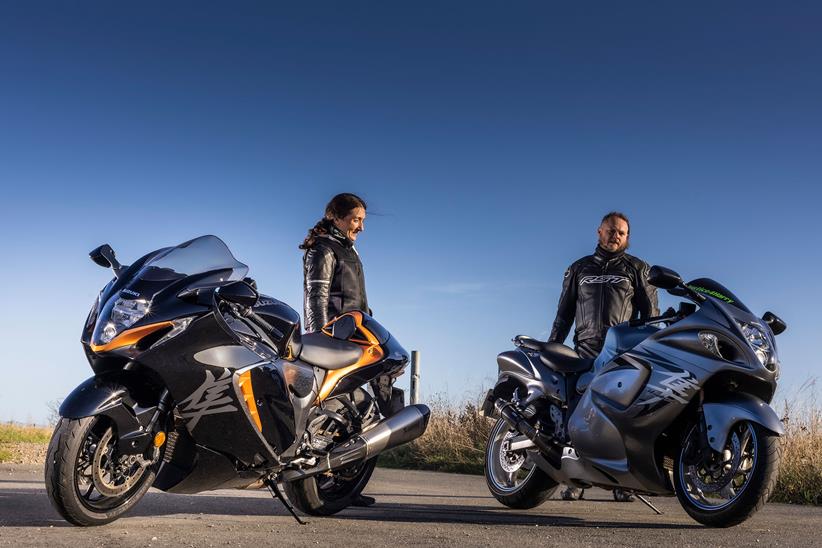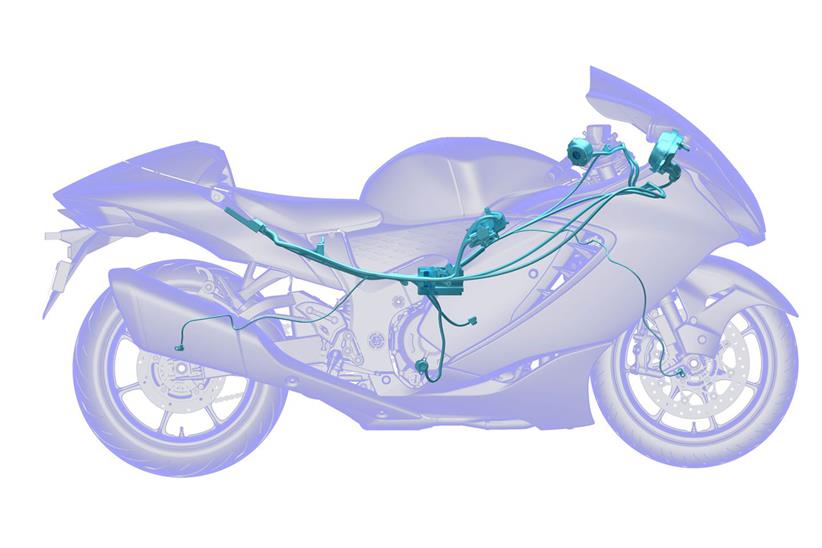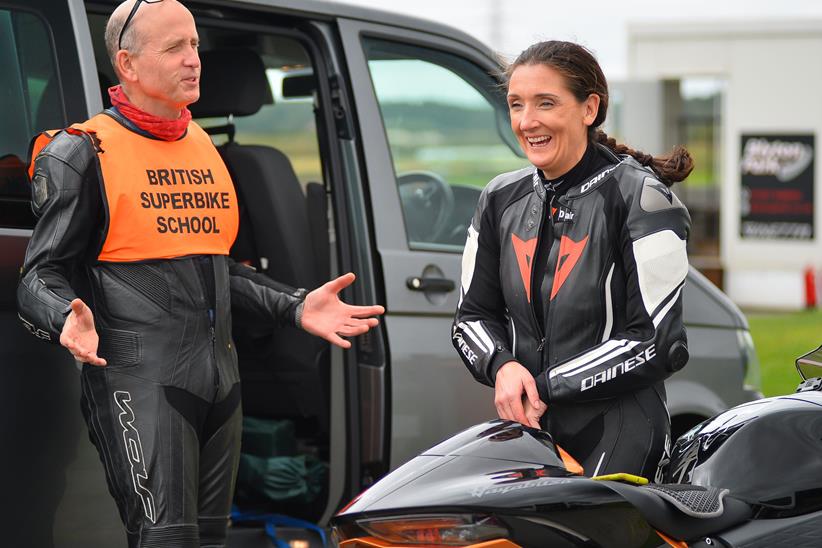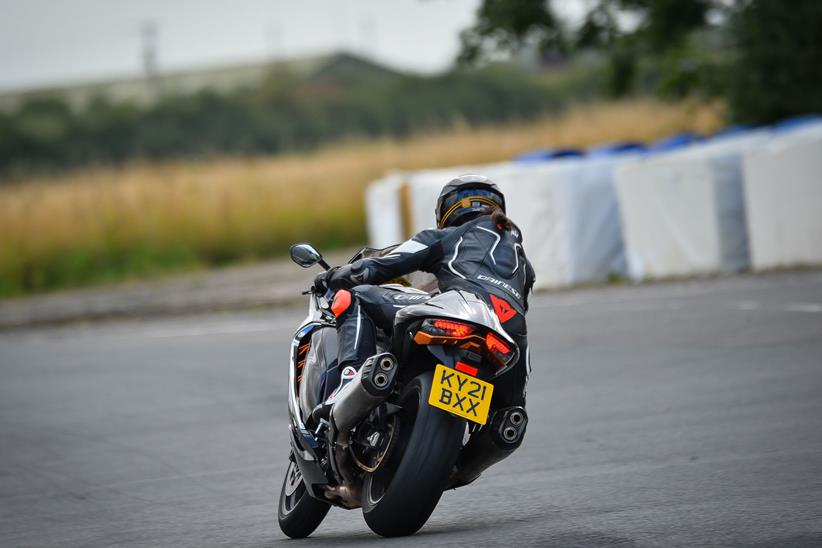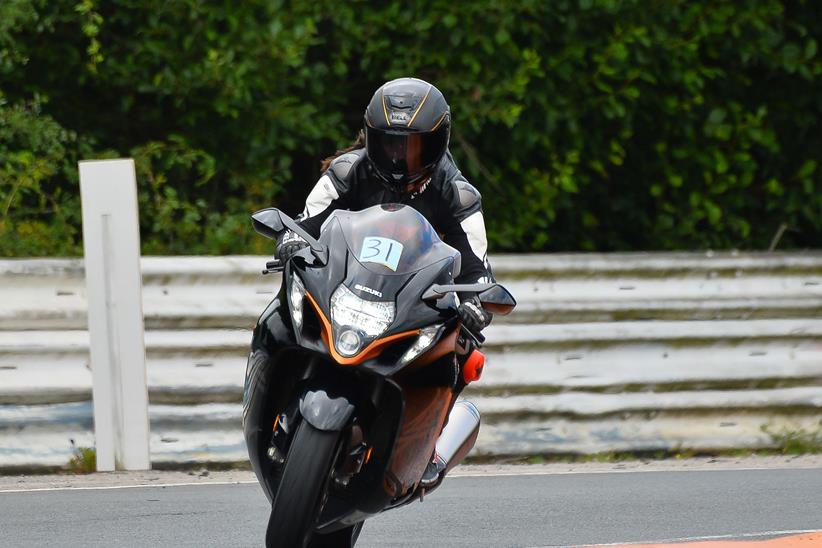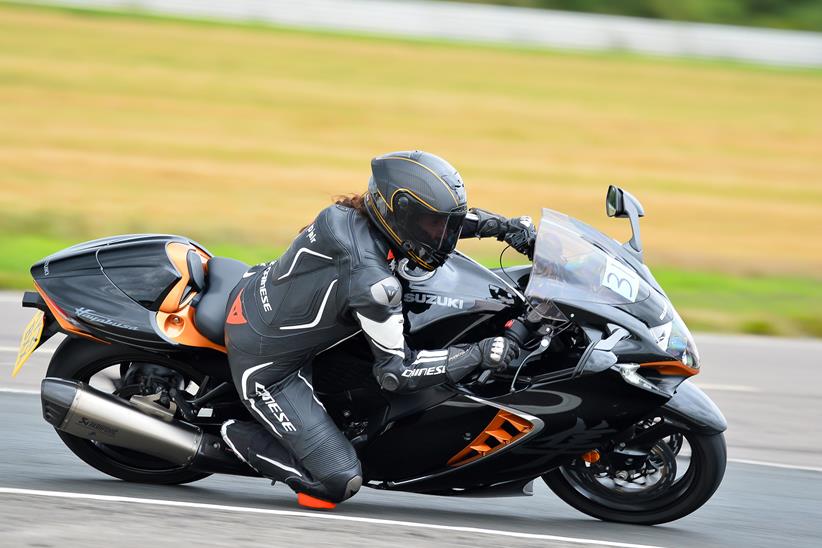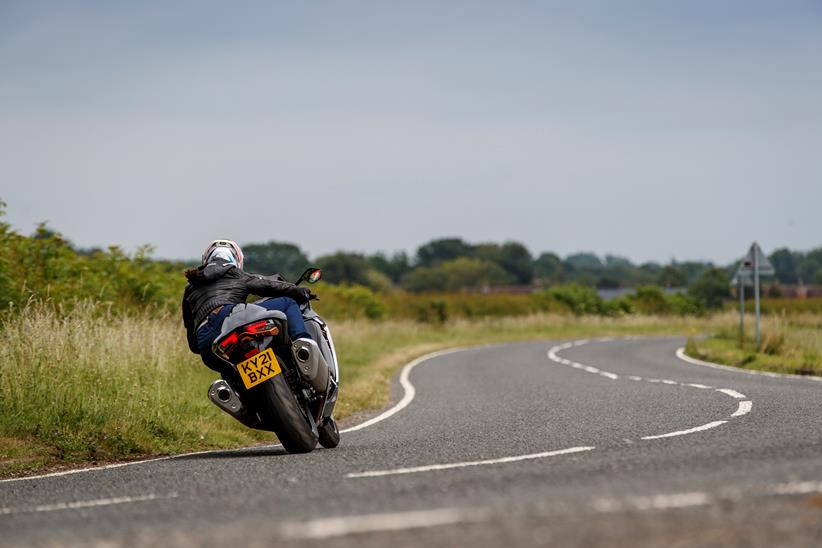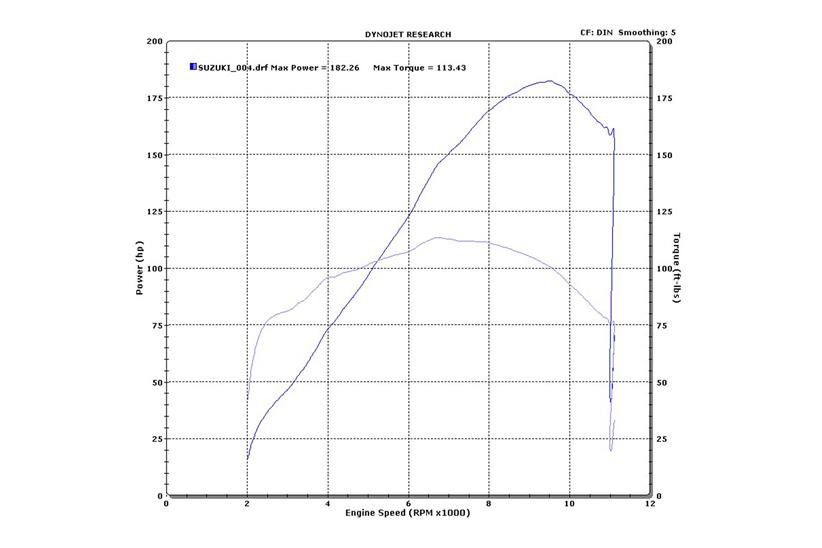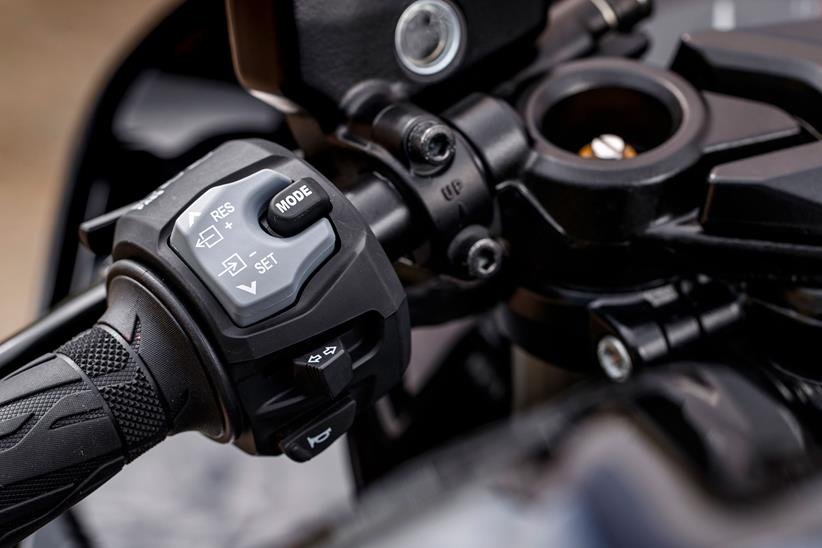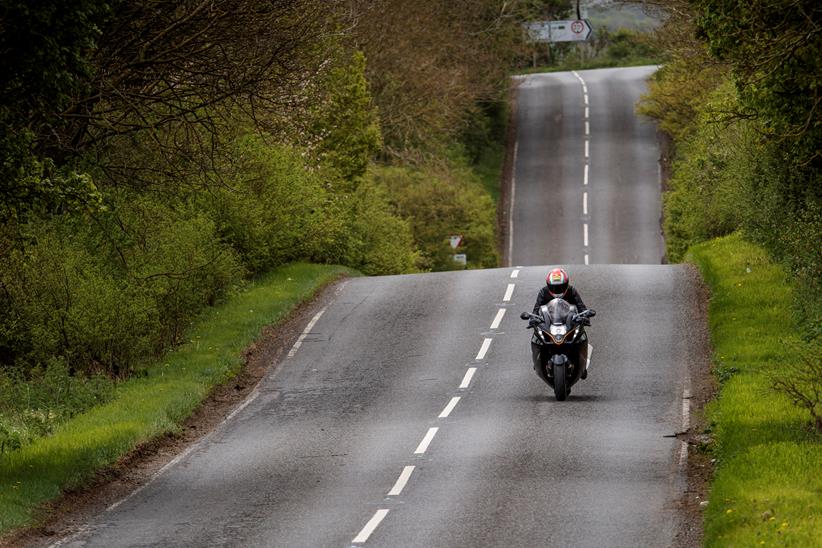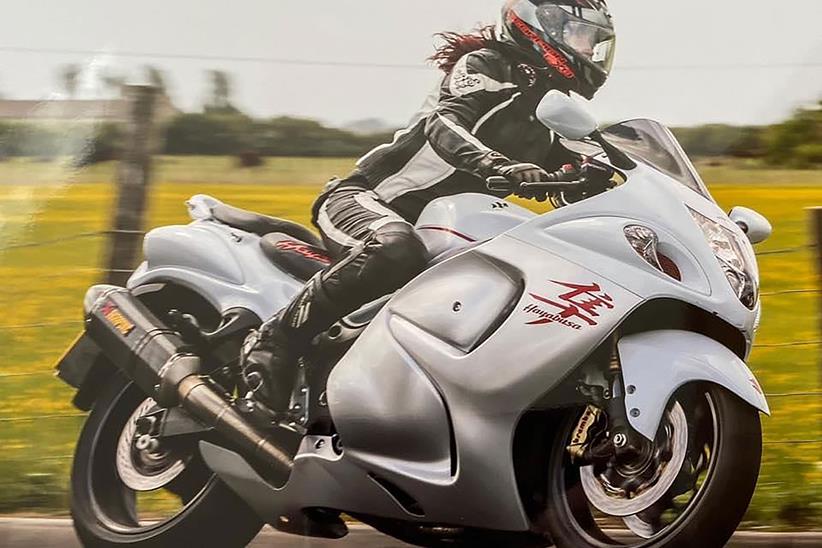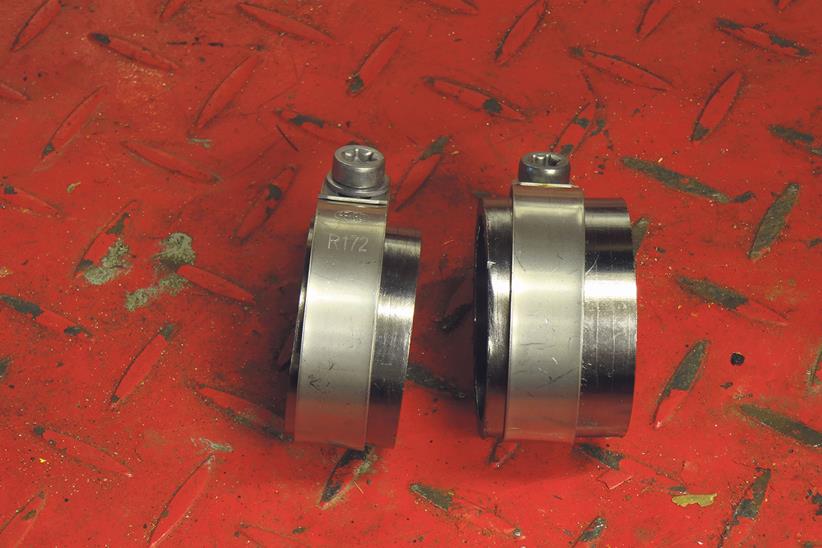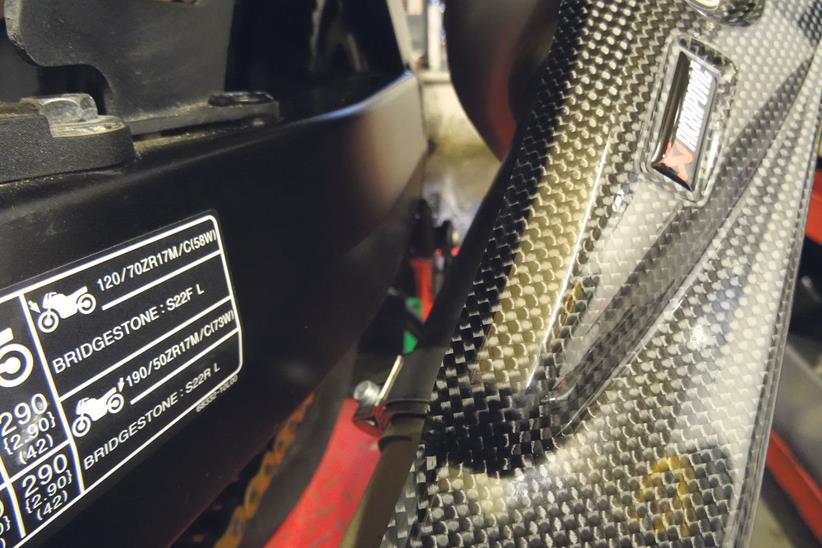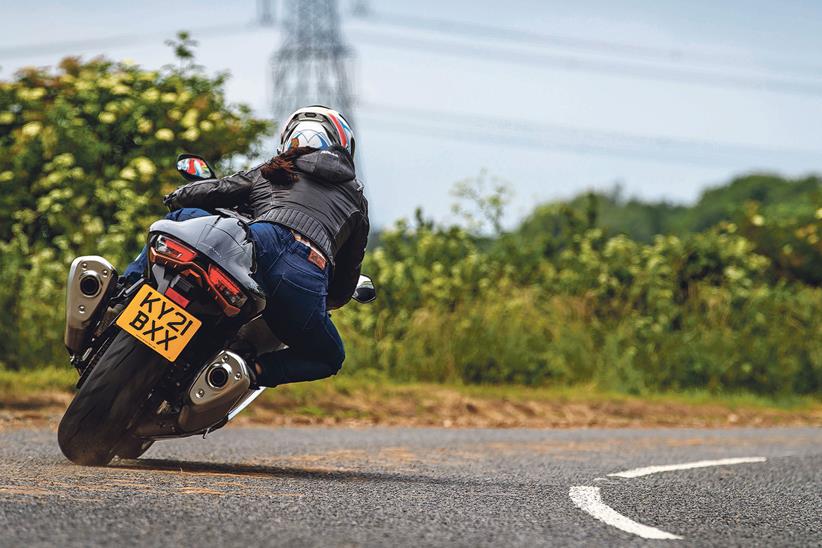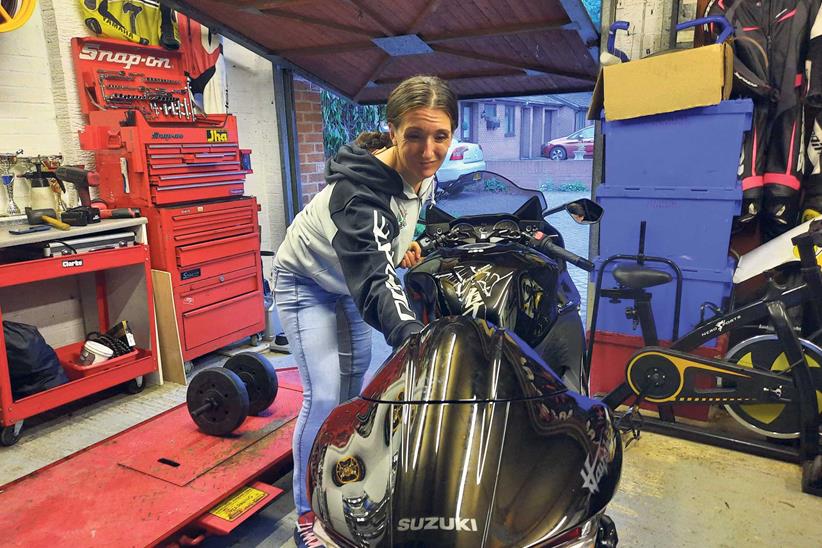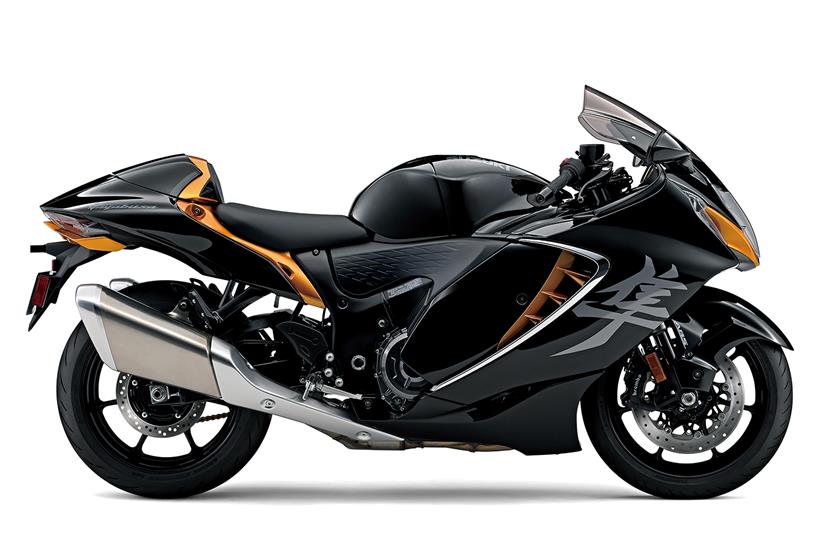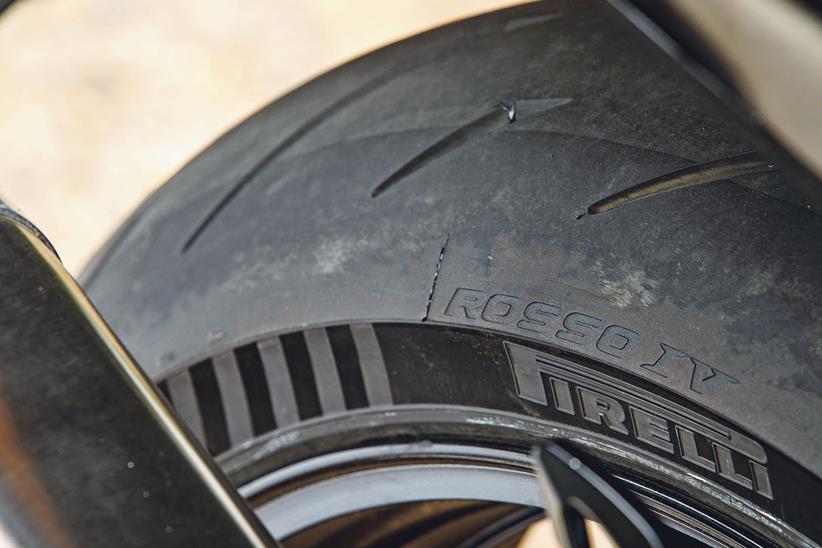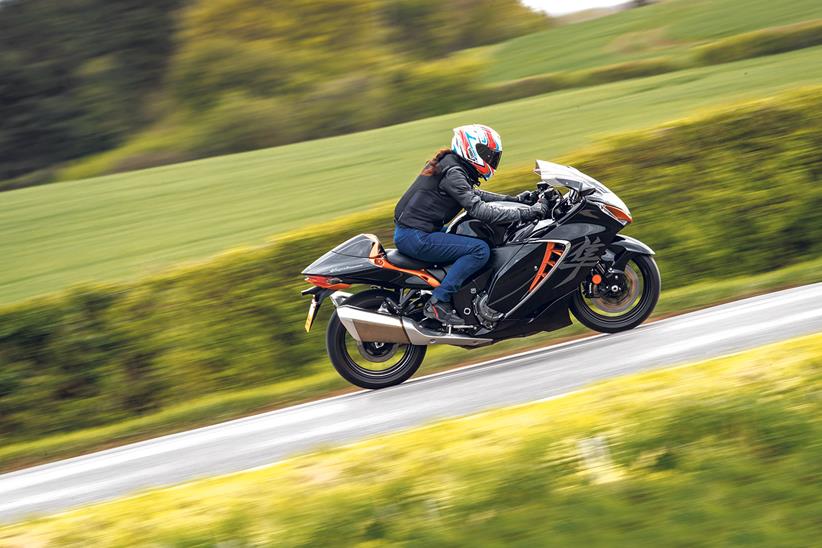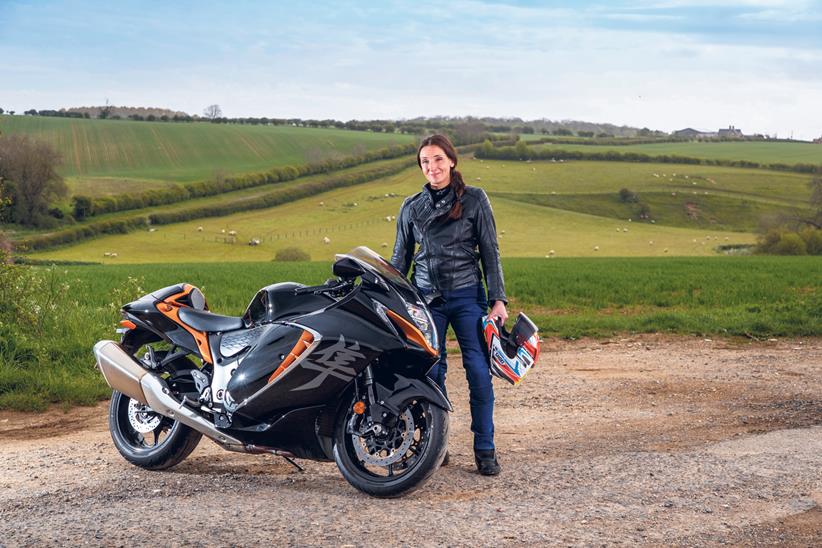MCN Fleet: Emma speaks to Gen 2 Suzuki Hayabusa owners
Peerless, that’s the best word to describe the 2021 Suzuki Hayabusa – there’s simply nothing quite like it. While manufacturers endlessly follow each other down the retro and dual-sport routes, Suzuki stuck its neck out and decided to wheel out something unique.
Which is great when it comes to getting noticed, but perhaps makes things a little more challenging when it comes to enticing owners of other makes and models to make the switch; you either want a Hayabusa, or you don’t.
Fortunately for Suzuki, the Busa’s cult following is such that the new bike has caused quite a stir amongst current owners. MCN reader Matt Brown is one of them.
![]()
He’s had his name on the logbook of a Busa since 2016, after he first clapped eyes on a 2009 model for sale in his local dealership. He bought it there and then, and five years on he’s still in love and says the only thing that would tempt him away would be a Big CC Racing turbo version… Until, that was, he tried my Gen 3.
Matt and I recently met up and went for a B-road Busa blast, swapping bikes halfway – which gave him a bit of food for thought. “The engine is a powerhouse!” he said. “I know people were disappointed it didn’t have a supercharger or a turbo, but I think that would have put the cost out of a lot of peoples’ reach, and besides, it just feels really strong as it is.
“The Gen 3 is more refined, it’s a proper grown-up bike and at one point I would love one – but the thing is, I haven’t grown up yet!”
Even if Matt’s going to wait a couple of years before getting his hands on a Gen 3 Busa, there are plenty of UK Busa owners who have decided to splash out on a box-fresh new one.
More long-term tests
- 2021 BMW S1000R long-term test
- 2021 Kawaski ZX-10R long-term test
- 2021 Yamaha Tracer 9 GT long-term test
Sarah Thompson is one such person, having just decided to trade in her Gen 2. She’s now waiting patiently until March 1 when she collects her new hyperbike, but in the meantime shared with me her reasons for trading up: “I’ve been a Hayabusa owner for two years. I fell in love with them after going to a meet down in Spain with my husband shortly after he got his. At the meet, I was one of the only few people there not on a Busa.
“Needless to say, that changed when we got back home! My husband bought a Gen 3 last year and when I had a go, well the difference between the two was just so amazing, that I had to get one myself. It’s just so much smoother, the mid-range is even stronger, and the handling makes it feel like there’s a computer or camera inside the bike which somehow knows where you want to go.
“I’ve always liked to be just a little bit different from the crowd and the Busa allows me to do that in such an amazing way. There’s just nothing quite like it.”
Suzuki Hayabusa previous updates:
- Update one: I want to explore the Busa’s potential
- Update two: Power Games
- Update three: A weighty issue for the Suzuki Hayabusa
- Update four: Hayabusa gets treated to a pair of pricy-but-perfect pipes
- Update five: Hayabusa’s rubber revolution
- Update six: The Hayabusa takes on its first track day
- Update seven: After six months with the big Suzuki, Emma reveals her thoughts
- Update eight: Exploring the electronics
Update : Exploring the electronics on the Suzuki Hayabusa
Published: 20.02.2022
![]()
The third generation of Suzuki’s legendary Hayabusa has been reborn smarter.
Whereas the previous iteration of Busa could only boast a basic three-level drive mode selection, and ABS on later bikes, the 2021 Suzuki Hayabusa offers the rider a dizzying array of electronic options and adjustability.
There are now three switchable drive modes: 1 gives full power and a sharp throttle response, 2 allows full power but a easier delivery, and 3 gives soft delivery and a lower peak power.
There are also two levels of bi-directional quickshifter sensitivity – the first requires more of a firm boot-full at the shift lever for aggressive shifts, whereas the other setting produces shifts at a much lighter touch.
You get 10 levels of IMU-assisted traction control too (which can be turned off), and in my experience of it on road and track it’s really good, being easy to alter and really unobtrusive on its lower setting.
![]()
It was reassuring to have it on track at Blyton Park, especially when going through Lancaster corner, a big-lean, high-speed bend leading onto the back straight. There’s also Bosch lean-angle sensitive ABS, which works brilliantly and is well worth having.
More long-term tests
- 2021 BMW S1000R long-term test
- 2021 Kawaski ZX-10R long-term test
- 2021 Yamaha Tracer 9GT long-term test
Another electronic gizmo I love is the cruise control – which is super-simple to set and beneficial for motorway riding (providing you get a section of motorway clear enough to make the most of it, that is!) .
In terms of what I don’t like, the 10-level anti-wheelie control has me really scratching my head as to the point of it. Despite its huge power and acceleration capability, the Hayabusa naturally has beautiful drive courtesy of its sheer bulk and long wheelbase, so wheelies – and controlling them – have never been an issue.
Then there’s the hill hold control for uphill getaways – not only do I think it’s another pointless feature on a bike as low to the ground as a Busa, but once or twice it’s also destabilised me as I’ve attempted to pull away because it releases the back brake too slowly.
![]()
That said, the combination of the super-natural-feeling ride-by-wire throttle, the ability to control engine braking (a first on any Suzuki), and the easy to navigate settings menu mean that overall, as a package, the Hayabusa’s newfound intelligence is nothing short of genius.
Suzuki Hayabusa previous updates:
- Update one: I want to explore the Busa’s potential
- Update two: Power Games
- Update three: A weighty issue for the Suzuki Hayabusa
- Update four: Hayabusa gets treated to a pair of pricy-but-perfect pipes
- Update five: Hayabusa’s rubber revolution
- Update six: The Hayabusa takes on its first track day
- Update seven: After six months with the big Suzuki, Emma reveals her thoughts
Update seven: After six months with the big Suzuki, Emma reveals her likes and dislikes
Published: 20.12.2021
![]()
2021 has been a funny old year. All the lockdown ‘must do’ lists dreamed up during 2020 have mostly failed to happen. Whether it was due to ongoing travel restrictions or just a case of readjusting to life rushing back, time and opportunity have not been on my side this year.
That said, the Suzuki Hayabusa has been a light in the dark; an unfailing source of proper pleasure whenever I’ve opened the garage door… even if I never quite made it over to Europe for the autobahn storming and alpine pass scything that I daydreamed about last year.
More long-term tests
- 2021 BMW S1000R long-term test
- 2021 Kawaski ZX-10R long-term test
- 2021 Yamaha Tracer 9GT long-term test
However, with 4000 miles of B-road blasting, long-distance days, and even a track session thrown in, I’ve definitely reached some conclusions about the new Busa.
![]()
Comfort – hit
Just by bringing the bars 12mm further towards the rider, the new Busa’s riding position is so much more comfy. I remember being massively disappointed with the Gen2 when tackling long motorway rides; the seat gave me arse ache after 150 miles, and the stretch over the tank used to cause a burning sensation right between my shoulder blades.
Not anymore. In the summer, I boshed off a 500-mile day trip to Exeter and back, stopping only for fuel, and felt fresh at the end of it. The seat is proper plush too, and I love the cruise control.
Fuel economy – miss
![]()
I hate everything about going to the petrol station: the cost, the faff, and having to actually stop. But until they make a nuclear-powered bike, it’s something I’m going to have to live with.
The 2021 Busa’s tank is two litres smaller than the previous model, and the new bike appears to be thirstier too.
Whether that’s down to the Euro5 engine updates or E10 fuel, or a combination of both, I feel like I can visibly see the analogue gauge dropping as I ride.
It’s currently returning an average of 36.5mpg; the fuel warning light comes on at 115 miles, and it’ll do just over 150 miles to a tank. I expected more, really.
Electronics – hit
For all its power, the Busa has always been very easy to exploit so arguably doesn’t need traction, lift and launch control. But obviously gizmos like this are must-haves these days, which is why Suzuki bestowed the Gen3 with a full suite of IMU-controlled electronics.
And they all work really well. The ride-by-wire throttle response is beautifully smooth with a decent feeling of connection; the traction control is unobtrusive and confidence inspiring, but the crowning glory is the two-way quickshifter, which is by far the best I’ve ever used. It almost feels like the Busa’s got a MotoGP bike’s seamless shift gearbox!
![]()
Engine performance – hit
I scratched my head a bit when Suzuki said they’d beefed up the 2021 Busa’s mid-range – as if it needed more power anywhere!
But you know what, the engine is even better as a result. There’s 10bhp and 10lb.ft more power and torque at 6750rpm over the previous model, and that’s at seemingly no sacrifice to peak power, either; on our dyno the Gen2 made 182.7bhp whilst the new bike makes 182.2bhp.
The result is record-breaking acceleration, and also real-world drivability too. Short shift it or rev it – there’s just masses of grunt everywhere!
Dash menus – miss
![]()
Even though I adore the analogue-digital hybrid instrument panel, I find the basic menu system quite fiddly to use – scrolling between modes, trips, average speeds etc. is still a bit hit and miss for me, even after all this time.
The advanced sub menu, where you can fine tune your settings, is easier to use as it’s just a list that you scroll down. On the plus side, all the info contained within the TFT panel is really clear and easy to read – and I’m a little bit addicted to the lean angle and accelerometer display function!
Chassis – hit
The brakes and suspension on the new Busa are both a vast improvement over the previous model.
The Brembo Stylema calipers and larger front discs manage to give the new bike much-needed brake feel as well as power, although they do fade during hard track use.
The KYB suspension is excellent too – it’s set on the soft side so could do with a tiny bit of firming up, but it really offers limousine-levels of comfort over bumps, decent cornering precision and supernatural straight-line stability.
Suzuki Hayabusa previous updates:
- Update one: I want to explore the Busa’s potential
- Update two: Power Games
- Update three: A weighty issue for the Suzuki Hayabusa
- Update four: Hayabusa gets treated to a pair of pricy-but-perfect pipes
- Update five: Hayabusa’s rubber revolution
- Update six: The Hayabusa takes on its first track day
Update six: The Hayabusa takes on its first track day
Published: 01.11.21
![]()
“You’re not actually planning on riding that around here, are you?” They’re all sniggering as I roll up.
Yet what the other trackday-goers waiting to get out on circuit at Blyton Park don’t know is, that despite its weight and length, the 2021 Suzuki Hayabusa is a super-sized sportsbike at heart and far more capable round corners than appearances would suggest.
More long-term tests
- 2021 BMW S1000R long-term test
- 2021 Kawaski ZX-10R long-term test
- 2021 Yamaha Tracer 9GT long-term test
Having ditched the standard, flat-profiled Bridgestone S22 tyres in favour of a taller, more agile pair of Pirelli’s new Diablo Rosso IVs, the Busa’s got a new-found keenness to drop onto its side.
![]()
It responds to a firm shove on the inside bar and, once settled, sticks to the selected line like glue. With its standard settings, the Showa adjustable suspension is limousine-smooth on the road but much too soft for the track (I should’ve given a few tweaks to the rebound and compression adjusters, but didn’t find the time) so responds to aggressive inputs by yumping and yawing slightly, much to the amusement of onlookers.
“That looks awesome fun,” says one of the instructors. “It’s pulling some crazy shapes but it’s still flying. It’s great to watch!”
He’s absolutely right, awesome fun is exactly what riding the Busa on track is all about. It’d be easy to get put off by the thought of its 268kg weight and that 113lb.ft torque at 6500rpm, but despite those scary-sounding on-paper figures, in reality the Busa is something of an easy ride.
![]()
It’s length and weight gives the confidence to explore its tremendous shove when coming out of corners, especially when backed up by the safety net of traction control, which – stupidly – I had completely turned off at first then thought better of it later in the day, when I set it to Level 3; knowing it was there definitely helped my bravery levels.
It’s also quite an involved ride. As there’s not a vast amount of ground clearance, the pegs go down frequently, but reducing the lean angle by hanging off more certainly helps.
Likewise, getting through Blyton’s fast right-left flick at Port Froid takes a bit of body-swinging to get the Busa from one side of the track to another, but you certainly don’t need to be built like Peter Hickman to hustle it through.
![]()
Blyton’s a fairly tight circuit which means the Busa hasn’t ventured much beyond third gear today, but the gearchanges I am doing are all silky smooth and addictively efficient courtesy of the standard-issue two-way quickshifter – easily one of the best factory-fit units around. Why can’t all blipper systems be as good as this?
Towards the end of another session, the only hint of protestation is from the big Busa’s brakes. With new Brembo Stylema calipers and larger discs, it’s a vast improvement over the previous version’s wooden-feeling, lacklustre stoppers.
Using both front and rear brake hauls the Busa down from 150mph ready for Blyton’s tight right hander at the end of the straight very efficiently indeed.
But after 20 minutes of track use they’re starting to fade and I start to become very aware of the Busa’s potential as a runaway freight train so I’m relieved to see the chequered flag to give us both time to cool off. It’s been a great day and I’d love to get the Busa back on track after a few twiddles of the suspension adjusters to see how much better it could be.
Suzuki Hayabusa previous updates:
- Update one: I want to explore the Busa’s potential
- Update two: Power Games
- Update three: A weighty issue for the Suzuki Hayabusa
- Update four: Hayabusa gets treated to a pair of pricy-but-perfect pipes
- Update five: Hayabusa’s rubber revolution
Update five: Hayabusa’s rubber revolution
Published: 05.10.20
No more beating around the bush: the 2021 Suzuki Hayabusa is a brilliant performance road bike.
Sure, it’s taken me a few thousand miles to shake off my post-Lockdown rust, but I’ve finally reached the conclusion that, for someone like me who’s still not over the ‘sportsbike thing’ but wants real-world performance without having to go down the upright (and ugly) ‘dual-sports’ route, it’s the best mix of comfortable, practical show and go.
![]()
Lockdown rust blown away, a small change I’ve recently made to the flagship Suzuki has resulted in a big difference, too: tyres.
The 2021 Hayabusa on Bridgestone’s S22 tyres; 120/70/17 on the front, and a 190/50/17 at the rear. They’re absolutely fine in terms of grip, but I found they lacked feel and their rather flat profile meant they required a little too much effort to get the Busa turned in.
More long-term tests
- 2021 BMW S1000R long-term test
- 2021 Kawaski ZX-10R long-term test
- 2021 Yamaha Tracer 9GT long-term test
So, it was time for a change. Keen to try a pair of Pirelli’s new-for-2021 Diablo Rosso IV sports-road tyres (£358.58 rrp pair), I opted to break away from the OE tyre size at the rear and take a punt on a slightly taller 190/55. (Note, Pirelli don’t yet offer the Diablo Rossi IV in the Busa’s standard fitment).
The theory was that the 190/55 Pirelli’s larger radius (7mm over the OE Bridgestone, by my measurements), has the effect of raising the Busa’s rear ride height by the same amount, changing the bike’s overall geometry.
Basically speaking, it makes the front end work harder and should have the effect of reducing effort required at the bar, feeling as through the steering’s quicker.
And the result is brilliant. Not only do the new Pirellis give me that all-important feel that was missing with the Bridgestones, but also the combination of the front and rear profile have really improved the Busa’s agility.
At first I was worried that fitting this non-standard size might upset the electronics, but I’ve had no ill effects or warning lights flash up. Another worry was that I’d sacrifice some of the Busa’s stability at speed, but again, this seems to be fine too.
![]()
My only nagging hesitancy with the Pirellis is that the Busa might just be a tad too heavy for them. Although they’ve been performing fine on the road, a recent session on track left me wanting a little bit more support and control from the rear, and it makes me wonder if the Busa’s combination of weight and power might be a little too much for the construction of these versatile performance tyres when riding hard on track.
That aside, if you’re wanting a slightly keener-steering Busa then you should definitely try fitting a 190/55 at the rear.
Suzuki Hayabusa previous updates:
- Update one: I want to explore the Busa’s potential
- Update two: Power Games
- Update three: A weighty issue for the Suzuki Hayabusa
- Update four: Hayabusa gets treated to a pair of pricy-but-perfect pipes
Update four: Hayabusa gets treated to a pair of pricy-but-perfect pipes
Published: 12.09.2021
![]()
Standard silencers seem to figure quite highly on most new bike owner’s must-replace list.
As emissions regulations have got tighter over the years, factory-fitted end cans have got longer, bulkier and heavier, inspiring a whole aftermarket array of more aesthetically pleasing but road legal aftermarket alternatives.
The end cans on the new Suzuki Hayabusa, I have to admit, didn’t really stand out to me as being particularly unsightly. In fact, I think Suzuki’s stylists did a nice job with them. Sure, they’re large, but the suit the bike pretty well. And, to be honest I think I’m over the whole noisy exhaust thing now too.
I find it more embarrassing than pleasing, and I’m sure my neighbours will be thankful I’ve now come to this conclusion, after enduring many years living next door to me with my loud-pipe addiction.
That said, the motorcycling magpie in me is still very much alive and kicking so I can’t resist a bit of bolt-on beauty – which is why, when I first caught sight of the newly released, limited-edition official Suzuki Akrapovic slip-on silencers for the Busa, suddenly those standard cans began to look a little bit lardier.
With only 20 pairs available in the UK, the pair of beautifully crafted titanium slip-on silencers feature carbon-fibre tips and heatshields, as well as a laser-etched Hayabusa logo on the flanks, and the gorgeous light-golden hue that comes from high-quality Ti.
They’re fully type approved as road legal, come with a two-year warranty (if home fitted; three-year if fitted by a Suzuki dealer), do not require any fuelling set-up, and installing them won’t invalidate the bike’s warranty.
These factors combined go towards justifying the special Akras’ eyewatering price tag, which is £2876.05 – yes, that’s 17.5% of the bike’s price – but if you do decide to get a set fitted at the point of sale, Suzuki say this cost can be added on to any finance agreement you have on the bike, so you can spread the cost out on your monthly repayments.
More long-term tests
- 2021 BMW S1000R long-term test
- 2021 Kawaski ZX-10R long-term test
- 2021 Yamaha Tracer 9GT long-term test
Unboxing them in the garage prior to fitting, the Akras are mind-blowingly flawless in their quality and attention to detail; there’s not a rivet out of place nor a strand of carbon-fibre out of alignment – they are as good as you can get.
In terms of what they offer, the spec sheet claims a 4kg weight reduction over standard, a 2.6bhp boost to peak power, as well as an improvement to the Busa’s soundtrack.
With help of my trusty fishing scales (NB I don’t actually fish), I measured the standard pipes and heatshields at a combined total of 11.87kg and the new Akras with their carbon-fibre heatshields at a total of 8.24kg – meaning a weight saving of 3.63kg.
Fitting them was very straightforward thanks to the excellent instructions and design, taking about an hour and a half to do. And fitting an aftermarket exhaust yourself is one of those jobs that’s relatively quick and easy to do but also gives you a great big hit of satisfaction when you get to see the results at the end.
Fitting the Akras has increased the Busa’s premium feel and absolutely look the part too. The only slight disappointment for me was the noise – or rather lack of it. Yes, I know they are completely road legal but I was still expecting a little bit of extra growl when I first fired the newly Akra’d Busa into life. That said, once on the move the pipes have subtly enhanced the soundtrack, just as promised.
Suzuki Hayabusa previous updates:
- Update one: I want to explore the Busa’s potential
- Update two: Power Games
- Update three: A weighty issue for the Suzuki Hayabusa
Update three: A weighty issue for the Suzuki Hayabusa
Published: 08.08.2021
![]()
Seven years have passed since I last spent significant time with a Suzuki Hayabusa, a Gen 2 that I ran as an MCN long termer in 2014, and casting my mind back, I can’t ever remember being phased by its weight.
However, these days I’m having trouble manhandling my new long termer with the engine off. Backing it into my ever-so-slightly angled garage is a proper grit-your-teeth-and-push exercise, which often requires third party assistance. And if I’m parked up on slightly uneven ground with a full fuel tank I have to dismount in order lift the Busa up off its sidestand, or get a shove from a friend (which is embarrassing).
![]()
The logical conclusion is that the Gen 3 Busa must weigh significantly more than the Gen 2, why else would I be finding it a problem? The thing is, though – it doesn’t. Checking back through my notes, the fully fuelled 2014 bike measured 265.8kg on MCN’s scales – exactly the same as the current model.
More long-term tests
- 2021 BMW S1000R long-term test
- 2021 Kawaski ZX-10R long-term test
- 2021 Yamaha Tracer 9GT long-term test
With both evolutions of Busa identical in mass, I’ve reached the conclusion that this weighty issue is completely down to me: my riding tolerances, attitudes and – dare I admit it – physicality have changed, so much so that something which wasn’t even an issue seven years ago has now become a daily bugbare. Yes, I’m officially a grumbling, aging weak ass who should obviously stick to riding small, lightweight bikes.
Or perhaps not… I recently took a ride on a colleague’s BMW S1000XR and was amazed with the ease at which I raised it up off its sidestand, despite me not being flatfooted on the floor. On the move, too, everything felt light and easy – from the throttle to the steering. Never at any point did I feel like I was managing a large 1000cc adventure-sports machine.
It just goes to prove the significance of ergonomics and weight distribution. At 240kg, the XR is still a heavyweight bike, yet because of its wide bars and taller packaging it feels easier to interact with than the low-slung and long Hayabusa .
Now, don’t get me wrong – once out of the garage and on the move, the legendary Suzuki still makes me smile in a way no other bike has ever managed to replicate, and its long-n-low stance and mass conspire to produce that uniquely devastating stability under acceleration. However, this new issue regarding its weight has made me appreciate how our biking preferences can change over time, and also how much a bike’s packaging and stance – rather than it’s out and out weight – makes to how easy it is to interact with. In the meantime, though, pass me the spinach…
Suzuki Hayabusa previous updates:
Update two: Power games for the Suzuki Hayabusa
Published 08.06.2021
![]()
The Suzuki Hayabusa is back! Not only has the Hayabusa returned to Suzuki’s line-up after two years banished to the wilderness by Euro4, but it’s also back in my garage. I had the pleasure of running the previous generation Busa as a long termer back in 2014 and had a brilliant year of high-speed hijinks, including taking it to 200mph using nothing more than an electronic derestriction and Yoshi exhaust system, nailing a sub 10-second quarter mile, as well as a unforgettable ride around the NW200 course. So yes, time to declare an interest: there’s certainly a great big aerodynamically sculpted place in my heart for the Hayabusa. But with its fancy new frock, suite of electronic ride-enhancing gadgets and new Euro5-compliant engine, will the 2021 model give me the same smiles-per-hour as before?
So far so good, at least as far as engine performance goes. The new Busa’s heavily reworked motor – which shares the same crankcases, compression ratio, and bore and stroke as before but very little else – offers big, backside-kicking barrages of boost absolutely everywhere, but more so in the middle. I must admit, when I first heard about the 2021 Busa’s fattened-up midrange my initial thought was: why? – I can’t recall many people decrying the big Suzi for its lack of grunt.
Then the cynical side of me dismissed it as some sort of marketing mind trick designed to detract from the fact that the Euro5 bike makes less peak power, after all Suzuki claimed 194bhp for the Gen2 Busa, but ‘just’ 187bhp for the 2021 model.
More long-term tests
- 2021 BMW S1000R long-term test
- 2021 Kawaski ZX-10R long-term test
- 2021 Yamaha Tracer 9GT long-term test
However, a run on MCN’s regular dyno proved my cynicism wrong. Not only does the new Busa kick out 10bhp and 10lb.ft more at 6250rpm than the old bike, but also – and despite our first thoughts – does so at no expense to top-end power, with both new and old bike producing almost identical peaks of 182.26bhp and 182.96bhp respectively. Taking a look at both graphs side by side also reveals that the new Hayabusa produces more linear power and torque curves than before, making for an increased sensation of turbine-like drive.
![]()
So, far from the new bike making less outright power, as many have been getting their knickers in a twist about online, it seems like Suzuki have perhaps just started quoting rear wheel power figures in their spec, as according to our graphs, the gap between claimed and tested power has dropped from a 12bhp discrepancy with the Gen2 to just 5bhp with the new Gen3. This tell-it-like-it-actually-is philosophy also carries on when it comes to weight, with Suzuki’s claims of 264kg being near-as-damn-it identical to the 265.5kg I got when I (and two strong helpers) weighed my fully fuelled Busa at home. Fair play, Suzuki.
Leaving the facts and figures behind and getting back to where it really matters out on the open road, the Busa’s a world away from the exquisite-yet-peaky Honda CBR1000RR-R Fireblade I ran last year, and in matter of miles, it’d made me fall head over heels back in love with road riding again.
![]()
The Busa’s effortless ability, smooth drive, plush suspension and unique road presence combine to form a package that’s thrilling without being intimidating, sporty without being comfortable, and rapid with being (too) irresponsible. I’m now taking pleasure in executing swift, well-planned overtakes and maintaining a brisk pace on fast, flowing A and B-roads.
It’s almost like the Busa’s encouraged me to rediscover the art of road riding, with all the observation, interpretation and planning that goes with it, rather than just spending all my time frustrated and wishing I was on a racetrack… I can’t wait to discover more about its strengths and weaknesses on some long-distance fun rides I’ve got planned for the summer.
Update one: I’d like to explore the Suzuki Hayabusa’s straightline potential
Published 14.04.2021
![]()
I’ve a soft spot for the Suzuki Hayabusa after running one in 2014 and managing to make it do 203mph. I’d like to explore its straightline potential on the strip as well as seeing whether tweaks to the ergonomics have made it more comfortable.
The rider Emma Franklin, MCN Deputy Editor, 40, 5ft 7in. Riding for 18 years. Rides for fun on road and track. Emma.franklin@motorcyclenews.com
Bike specs 1340cc | 187bhp | 264kg | 800mm seat height
Watch our expert reveal video of the Suzuki Hayabusa here:
